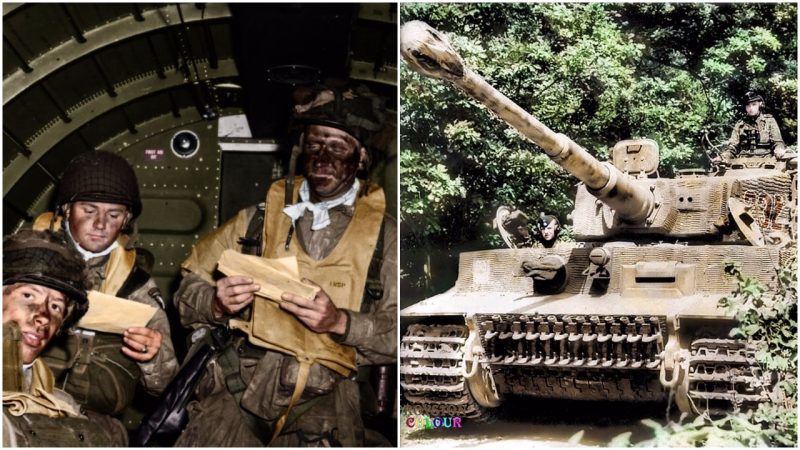Taken over 73 years ago – now we take for granted the modern day image – we have more on our smartphones than ever before. Now take into account the fact that we are used to seeing WW2 in black and white so when you see them in ‘colour’ – they have a major impact. The war seems very ‘real’ all of a sudden and it brings a different dimension to it.
As you may know, we are big fans of the Facebook page WW2 Colourised Photos, not only do they produce beautiful colorized images but they also spend a great deal of time researching each image, which just helps to keep history alive. Again, don’t forget to follow them on Facebook
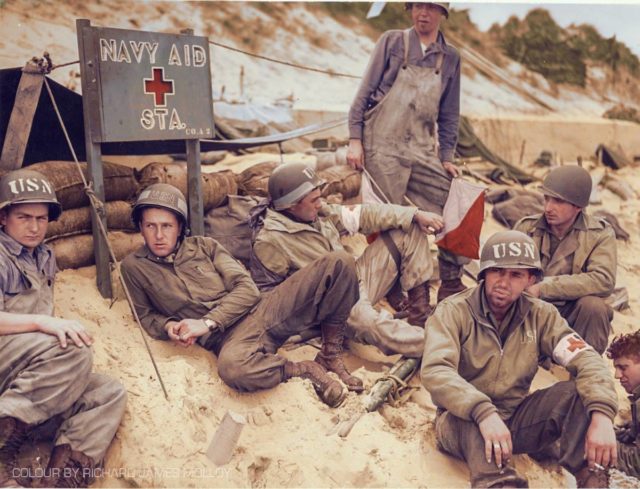
A Navy Aid Station. – The 2nd Naval Beach Battalion Corpsmen, await business on UTAH Beach
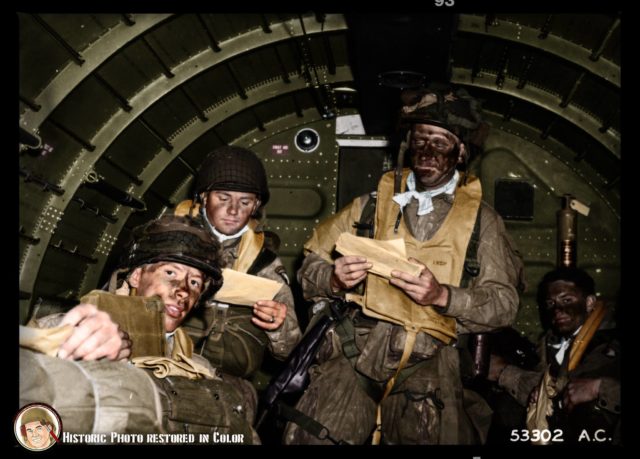
Men of Fox Company 101 st Chalk#81
Pfc D.A. Emelander , Pvt Harvey Morehead, 1er Lt Carl B MacDowell -Jumpmaster and T/4 William D Green. Prior to departure , Col Robert Sink provided this message to the paratrooper of the 506th.
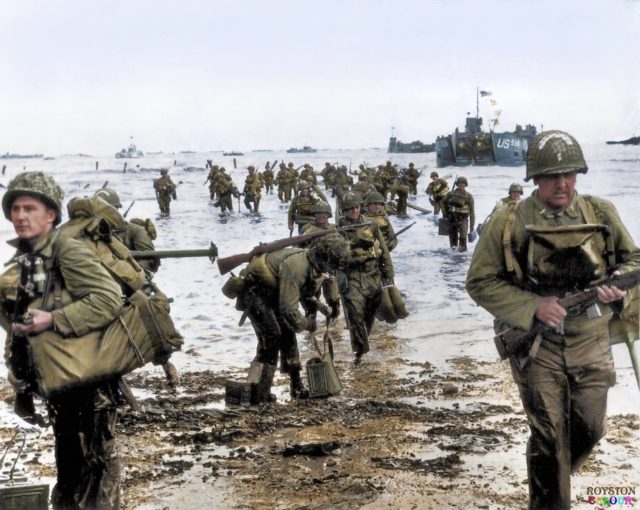
US assault troops shown coming ashore from LCT (Landing Craft Tank) 538 at ‘Red Easy Sector’, Omaha Beach as part of the 37th Engineer C. Battalion which was the assault battalion of the second assault wave in support of the 16th Infantry Regiment, 5th Engineer Special Brigade. 11.30-12.30 June 6 1944.
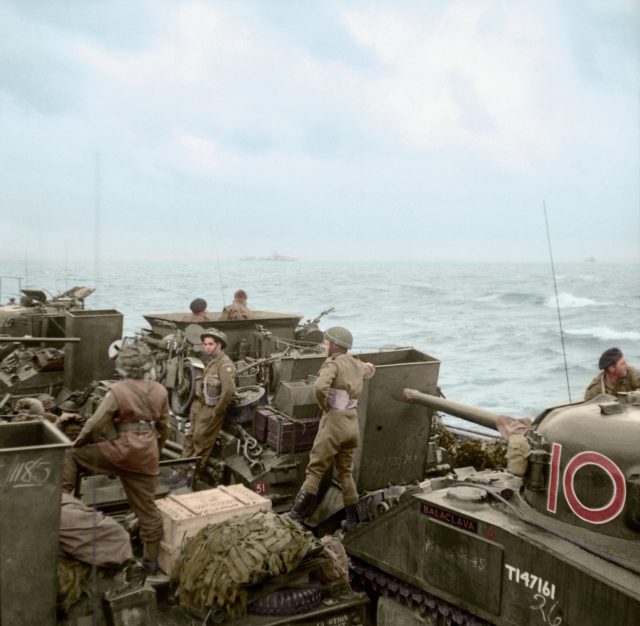
Sherman tanks, an ARV vehicle with BSA motorbikes strapped to it, and a jeep of 13th/18th Royal Hussars, 27th Armoured Brigade, aboard LCT 610/212 approaching the French coast, approx. 07.30 hrs 6th June 1944.
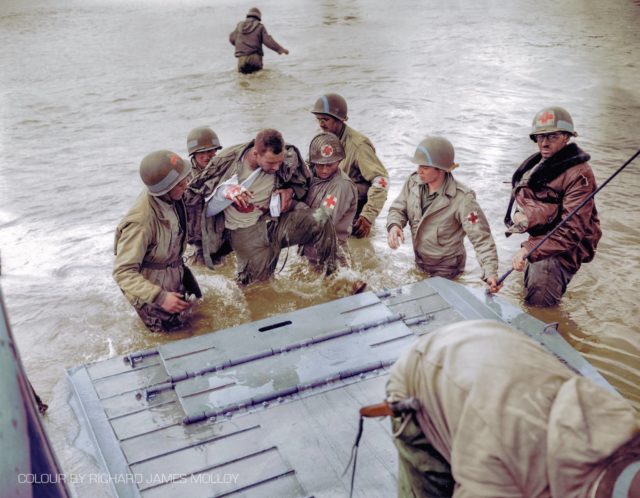
Medics from the 2nd Naval Beach Battalion and the 261st Medical Medical Battalion, 1st Engineer Special Brigade assist a paratroope as he steps onto the ramp of a LCVP that has pulled to Utah Beach at high tide. The work of the medics saved thousands upon thousands of lives.
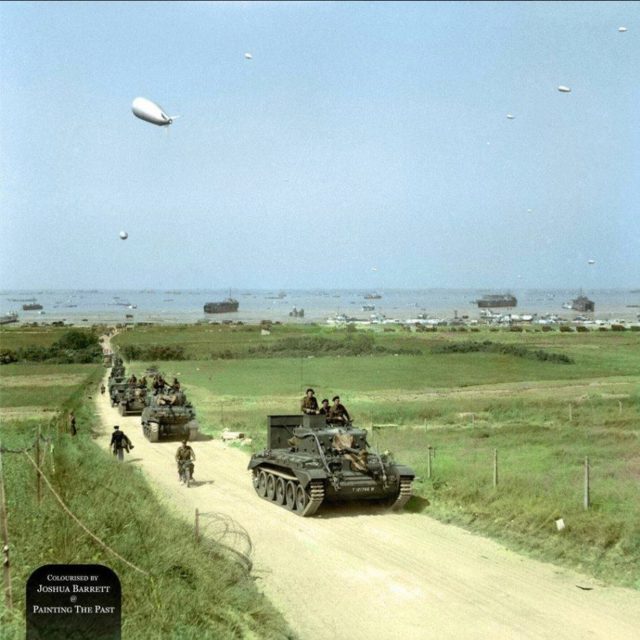
A British Cromwell Tank fitted with deep wading trunks heads an armoured column of the 4th County of London Yeomanry, 22nd Armoured Brigade, 7th Armoured Division inland from Gold Beach, Normandy June 7th 1944.
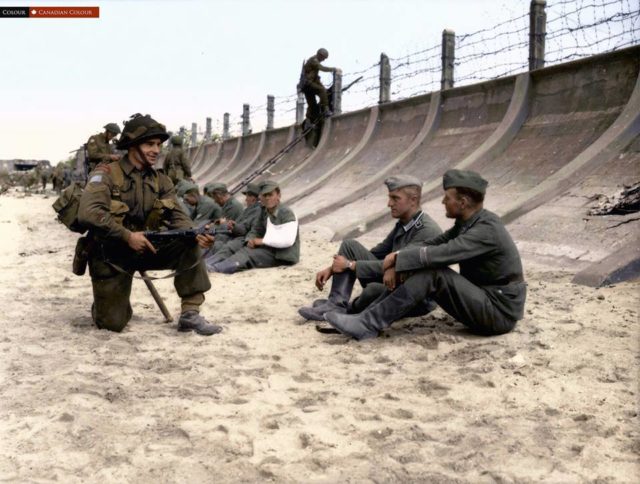
Corporal Victor Deblois of Le Régiment de la Chaudière guarding German prisoners on Juno Beach, Bernières-sur-Mer, France, 6 June 1944.
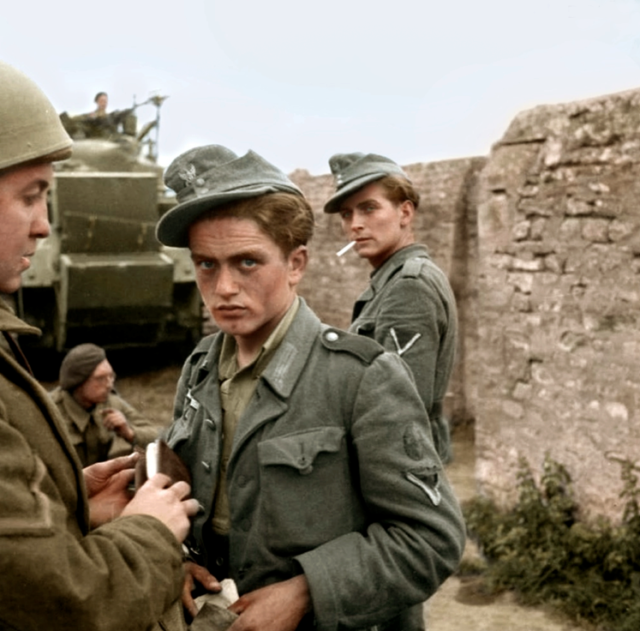
7th of June 1944. Near Saint-Gabriel-Brécy, Calvados, Lower Normandy, France.
Two young German POWs are searched after being captured by British troops during the Battle of Normandy. Both young soldiers wear the ‘Schwedter Adler’ badges on the front of their caps. A note from a follower – Brad James, “These are members of Reiter-Regiment 6, whose staff, 2nd and 4th squadrons, and 3rd motorcycle battalion wore the badge. All members of the 3rd Cavalry Division were also entitled to wear it.”
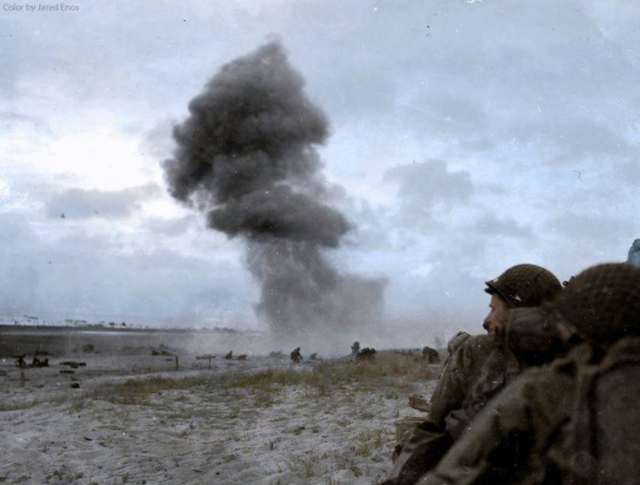
‘Utah Beach’ June 6th 1944. American troops exposed on the beach can be seen throwing themselves on the ground as a German 88mm shell explodes further down the beach. In the foreground others can be seen in the shelter of the sea wall.
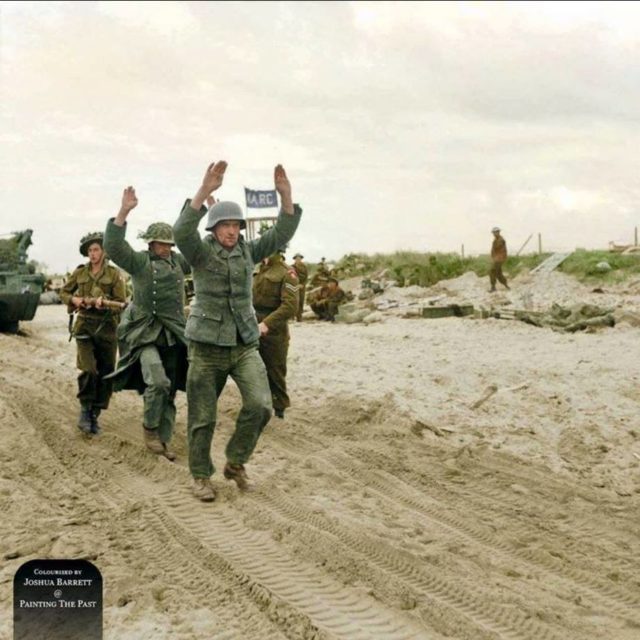
German POWs being escorted along one of the Gold area beaches, Normandy. 6 June 1944. These two British soldiers are thought to be from the No. 6 Beach Group which was a unit of the British Army responsible for organising the units landing on the Sword Beach in the Normandy landings on D-Day.
The Beach Group was tasked with establishing dumps of equipment and supplies including ammunition, petrol and vehicles. The Group controlled all policing and unloading in the eastern flank of the Normandy invasion area.
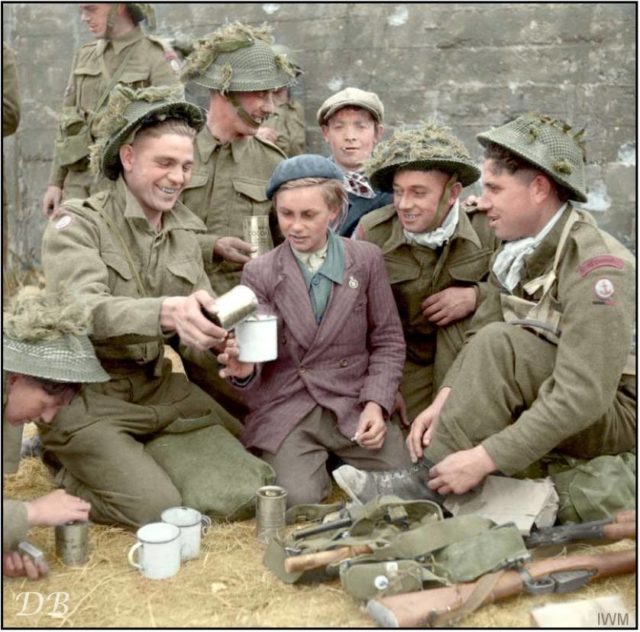
Royal Engineers serving with Nº 9 Beach Group supporting the 50th (Northumbrian) Infantry Division, share cocoa with a French boy in the village of Ver-sur-Mer, after landing at Gold Beach, King sector, 6 June 1944.
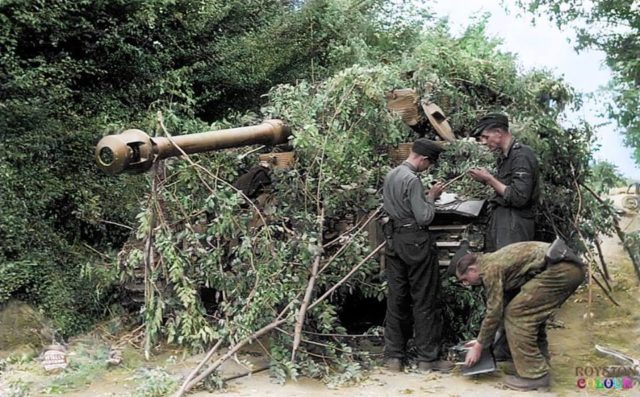
A Panzer crew, belonging to 1./
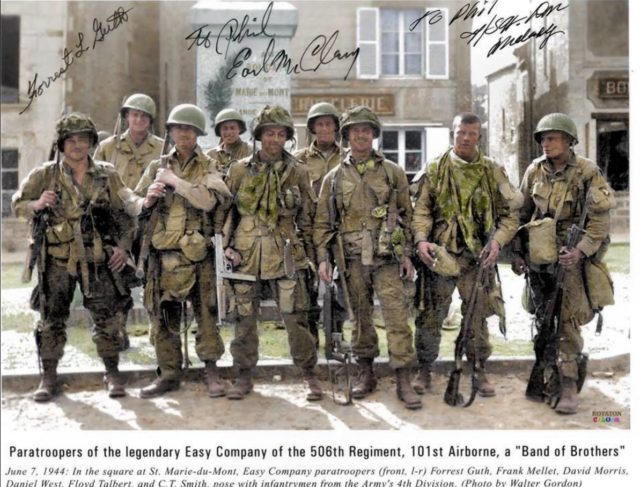
“Band of Brothers” – June 7, 1944. ‘Easy Company,’ 2nd Battalion of the 506th Parachute Infantry Regiment of the 101st Airborne Division, at Sainte-Marie-du-Mont, Normandy. Easy Company paratrooper Forrest Guth knew he would witness history when he jumped into France on D-Day, so he carried a camera borrowed from his boyhood friend and fellow paratrooper, Roderick Strohl.
On June 7, 1944, D+1, Forrest and his comrades entered Sainte-Marie-du-Mont while searching for Easy Company. Forrest thought the town’s WWI memorial would make a good backdrop. His comrade, Walter Gordon, agreed to snap a photo and Forrest let several 4th ID soldiers, fresh from Utah Beach, join them for a picture the world would one day treasure.
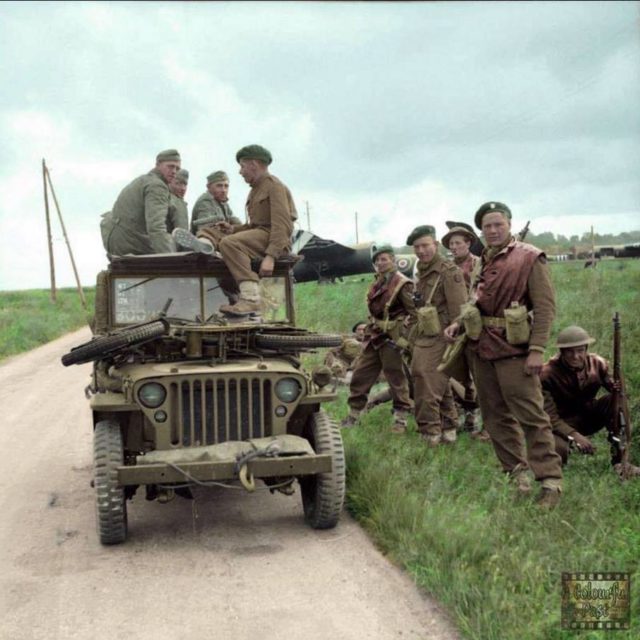
“Commandos of 1st Special Service Brigade with captured Germans on a jeep, with gliders of 6th Airlanding Brigade in the background, near Ranville, on the evening of 6 June 1944.”
More info found – The soldier on the right facing the camera is Frank Barton (later to be L/Sgt.) of the Royal Inniskillings Fusiliers and 6 Commando, also the location is LZ (Landing Zone) N by the side of the D514 road, not far from the farm used by Lord Lovat as a temporary HQ. Horsa CN 73 whose nose touches the road can be seen in the background.
Frank Barton had fought in North Africa in late 1942 and had been taken prisoner by the Italians. It was in a camp near Rome that he met his brother who had also been taken prisoner in Tobruk. When Italy surrendered in September 1943, Frank and his brother managed to escape back to England. Frank rejoined his unit (6 Commando), landed in Normandy on D-Day and fought through the rest of the war in North West Europe. He finally left the forces in the 50s.
(It is thought that he died sometime between 2009 and 2012)
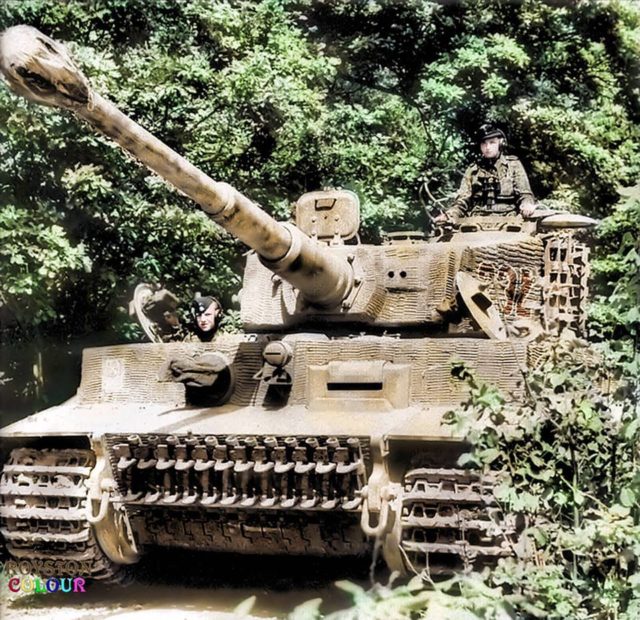
France, 6-12 June 1944. The day after the invasion, Michael Wittman’s unit, were given orders to depart from Beauvais to Villers Bocage. Arriving at the battlefront on June 12 after a road march from Beauvais via Paris, Schwere SS Panzer Abteilung 101 had endured many breakdowns and sustained air attacks. The drive from Beauvais to Villers-Bocage took the Battalion five days to move to the front.
